| After several days of hot sun, the weather had a cool
day. And when we went east to the Louisbourg Fortress, it got cooler still as
the fog and mist came down. There is a large harbour there but you could
have hidden an armada of ships because we could see nothing. |  |
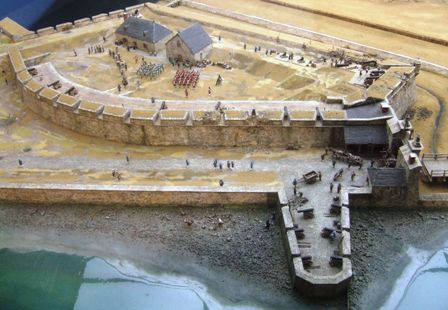 |
The fortress (fort + town) was once a busy seaport founded by the French in
1713. It was the administrative capital of French holdings in the Atlantic
provinces of Canada and
a major base for the cod fishing industry. The French built a fort there but it was taken by the English in 1743. It reverted to being French and was
seized again in 1758. The English finally dismantled it in 1768. The present
reconstruction was built in 1961 providing work in hard hit Cape Breton. |
| Highlighting the importance of the navy, there are
several ship models in fine detail including this one with 74 miniature
cannon. | 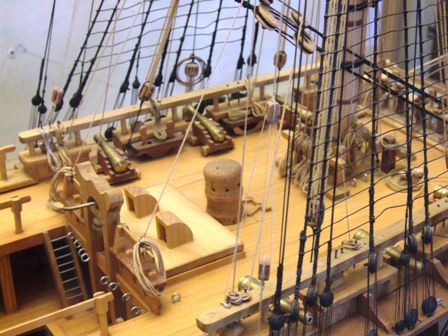 |
 |
Dozens of re-enactors populate the streets, some on guard looking for
English spies as on the left. His lieutenant was wandering around inside.
They are all bilingual and most have some Acadien ancestry. |
 |
| The entrance has an imposing gateway with a drawbridge
and a moat and an impressive coat of arms. In some respects it is almost
medieval but the famous military architect Vauban was instrumental in the
design. As in France, the designs were obsolete about the time they were
completed. | 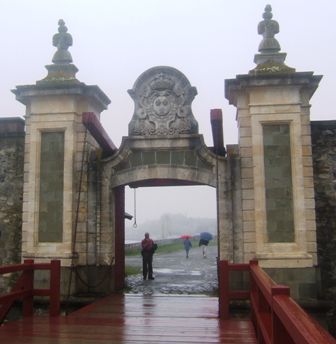 |
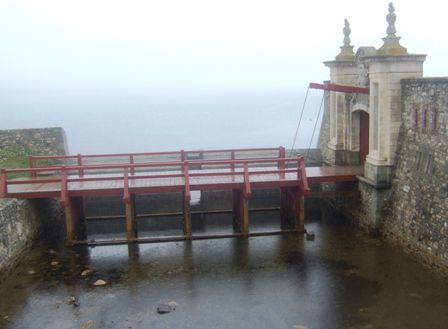 |
It all looks very impressive but it would have been very difficult to
realistically defend and proved impossible to keep supplied. It wasn't even
well positioned because it was overlooked. |
| This was one of the powder stores with its curved
ceiling which was designed to protect from above. The first time it was
occupied by the New Englanders and British it was captured after a siege of
six weeks in 1745. |  |
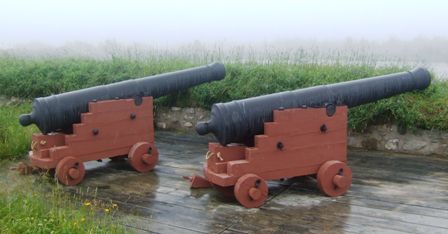 |
There are plenty of cannon about but probably less than there were on a
frigate of the time and everything had to be shipped here from France. There
were 40 cannon in the Royal battery guarding the seaward side which is where
they expected the attack to come from. |
| This is a bust of Etienne Verrier who supervised the
building of the defences from 1725 until 1745. He replaced Verville and was
succeeded by Pierre Jerome Boucher after it was returned to French ownership
from 1749-58. Boucher had served under both the original architects. The
total cost was less than that required to outfit a large warship of the
time. | 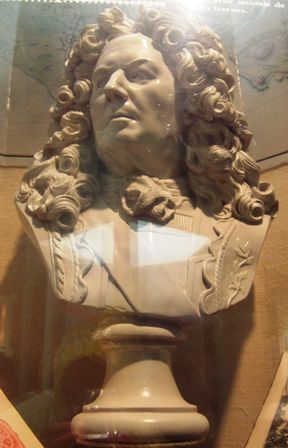 |
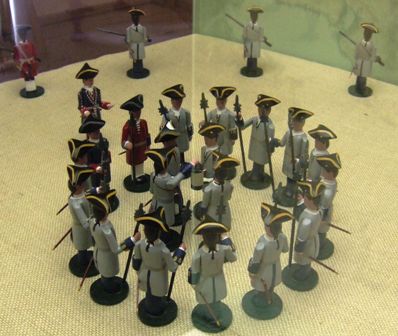 |
A few model soldiers in a daily ritual called a grand circle. The officers
at the centre gave out the orders of the day and the password was whispered
around the surrounding sergeants while the outer circle kept others away. |
| There are many buildings in the town like this
blacksmiths shop where other artisans give demonstrations of skills of the
day. Very little was actually constructed here at the time, most work was limited to
repairs. Most goods were shipped in from France making the colony dependant.
This policy was also used by the British and ultimately was the undoing of
many of the early colonies. | 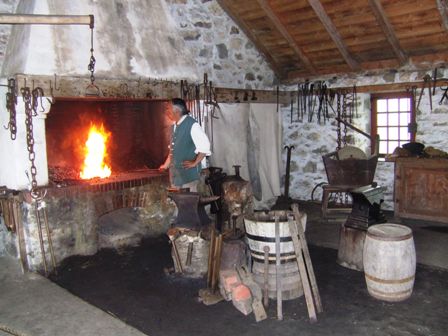 |
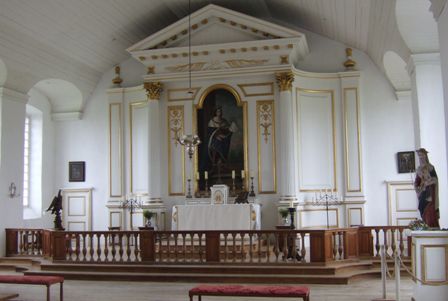 |
They always built an impressive church and the Catholics particularly so.
This was at the heart of the first occupation when the other New England
colonists (mostly non-Catholics) did not want to see catholic communities
prospering in the New World. |
| There was a small group of sisters of the Congregation
of Notre Dame who provided schooling for the young girls of the community.
This often meant that the young women were more skilled and literate than
their male counterparts who could only rarely read and write. Embroidery,
needlework and lace making were also taught. | 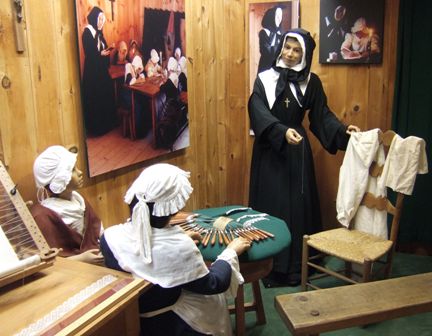 |
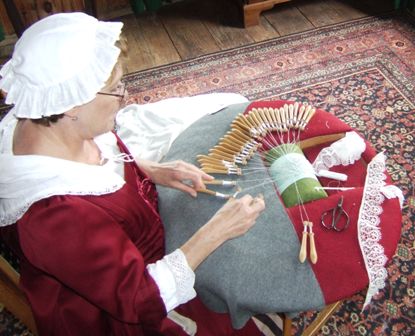 |
A few women still make lace, at least for demonstration purposes. It is a
very time consuming skill. |
| Several of the houses are furnished in period style.
A lot of plates are pewter but there are also French pottery plates and
other utensils on display. |  |
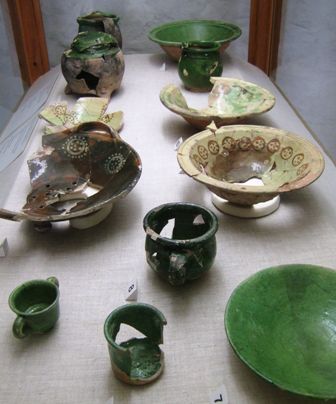 |
Over a million artefacts have been found in the archaeological digs on the
site enabling the origin of much of the pottery to be established. Many of
the Acadien settlers came from western France. This pottery is particularly
interesting to us because it came from the Haut Saintonge where we currently
live. Most of this came from La Chapelle-des-Pots not far from La Rochelle. |
| Although this was the far frontier in 1713, there was
still a society and women such as the governor's wife would have had
fashionable clothing. The population in 1740 was 2500 of whom the garrison
only numbered about 700. | 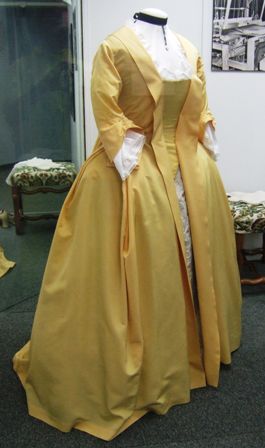 |
 |
There was a governor who was largely responsible for the military side and a
civil accountant who was effectively the tax man and almost as powerful.
This is the governor's dining room. There is a larger banquet room
upstairs. |
| His bed is quite grand although a little short and
narrow by modern standards. His wife probably had her own bedroom. | 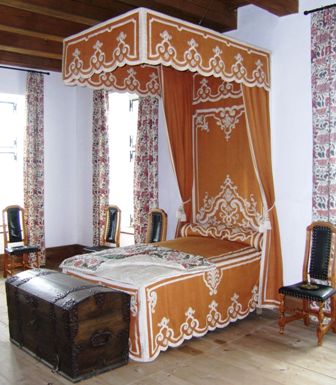 |
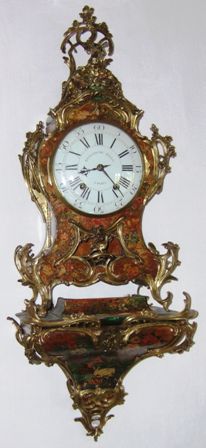 |
There is also this fashionable French clock, though not to my taste since I prefer
English clocks which were never so ornate, but maybe I'm biased. |
| There is this beautiful instrument in the music room.
This may have been a double manual harpsichord. Ladies in Society may well
have been quite accomplished on this instrument which was very fashionable
at the time. | 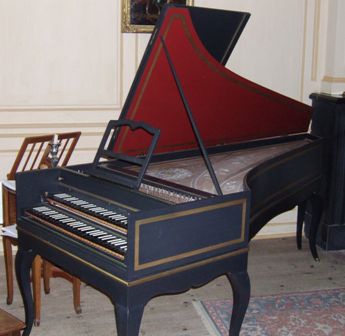 |
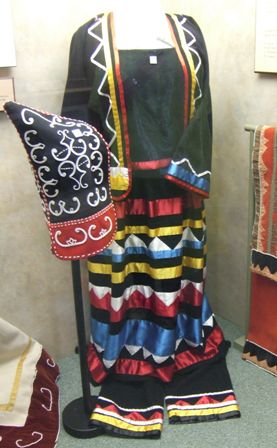 |
We should not forget the Mi'kmaq Indians who lived in the area and were
quite friendly with the French. Their chief was even converted to
Catholicism. A local member of the tribe made these traditional costumes for
the display just a few years ago.. |
| They also made very fine baskets. The Acadiens made
baskets and were displaying some of the traditional skills. Their baskets
are very similar to traditional French Breton styles and much less ornate
than these. | 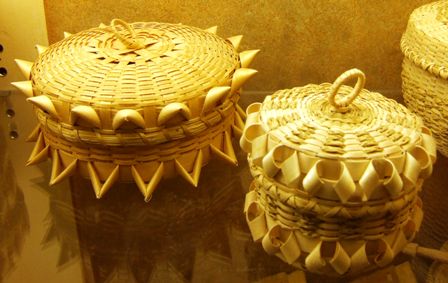 |
 |
Many of the buildings were built in different styles reflecting the
different home regions of many of the early settlers. This is a common style
in Normandy. |
|